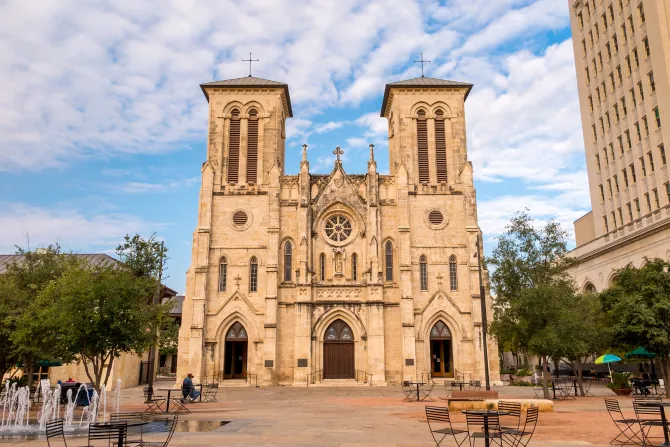Washington, D.C. Newsroom, Aug 22, 2024 / 15:30 pm
A first-of-its-kind study by the U.S. Conference of Catholic Bishops (USCCB) shows that 28% of parishes in the country offer Spanish-language Masses.
This number suggests a rise in the number of U.S. Catholic parishes offering Spanish-language Masses over the last 10 years.
Alejandro Aguilera-Titus, assistant director of Hispanic Affairs in the USCCB’s Secretariat of Cultural Diversity in the Church, said in a statement that the survey “reflects the dedication of our dioceses to Hispanic and Latino communities.”
He called the results of the survey “heartening” because it shows a “widespread commitment to build a more integrated and united Catholic Church in the United States.”
Survey findings
The bishops’ survey included data from 175 dioceses and 16,279 parishes. The survey found that 4,479 parishes — 28% of all U.S. parishes — currently offer one or more Spanish-language Masses.
Though there is no precise data to compare this number to, it suggests an approximately 10% increase from 2014 when the bishops reported that 81% of the about 5,000 parishes offering non-English Masses were celebrating Mass in Spanish.
Additionally, the survey said that 2,760 parishes have a Hispanic ministry presence but do not offer a Spanish-language Mass.
Not included in the survey were the Archdiocese for the Military Services, USA; the Diocese of St. Thomas in the U.S. Virgin Islands; the Personal Ordinariate of the Chair of St. Peter; and the Eastern Catholic eparchies in the U.S.
The Church’s Hispanic hotspots
The city with the highest number of parishes offering Spanish-language Masses in the U.S. is Los Angeles. The Archdiocese of Los Angeles has 240 parishes — that is, 83% of all parishes in the archdiocese — offering a Spanish-language Mass.
Southern California has an especially high concentration with 78% — 423 out of 540 — of parishes in the region’s four dioceses offering a Spanish-language Mass.
Texas and Florida are also hotspots for Hispanic ministry.
All but one parish in the south Texas dioceses of El Paso and Laredo offers a Spanish-language Mass. Meanwhile, a Spanish-language Mass is offered in all 72 parishes in the Diocese of Brownsville.
In the Archdiocese of Miami, 89 out of 109 — 81% — of parishes offer a Spanish-language Mass. The 20 parishes not offering a Spanish-language Mass still have some form of Hispanic ministry presence.
Why it matters
(Story continues below)
According to the Pew Research Center, Latinos make up 33% of the country’s total 52 million Catholics.
Philadelphia Archbishop Nelson Perez, one of the USCCB’s leaders in Hispanic evangelization, told CNA in an interview earlier this year that the spiritual health of Latino Catholics is vital to the U.S. Church.
He also shared that the bishops are aware of the danger posed by an increasing number of young Hispanics leaving the Church.
José Manuel De Urquidi, founder of a Latino Catholic ministry called the Juan Diego Network, told CNA that the survey further demonstrates the need for the entire Church, not just specialized Hispanic ministry offices, to evangelize to the Latino community, especially to the young.
“The vast majority of Gen Z and Alpha generations are Latinos,” he pointed out. “In order to have Latinos attend weekly Masses we have to go out there and try to understand them so we can evangelize them and form them so they are attracted to the sacraments. For this we need to do a lot of things as a Church, not rely on the overwhelmed and under-budgeted Hispanic ministries.”
The U.S. bishops released a pastoral plan at the end of last year to better minister to the country’s growing Hispanic Catholic population.
The plan is meant to be a guiding document in serving the country’s Hispanic population over the next 10 years, leading up to the 500th anniversary of the apparition of Our Lady of Guadalupe in 2031 and the 2,000th anniversary of the death and resurrection of Jesus Christ in 2033.
Commenting on the new survey, Bishop Oscar Cantú of San Jose, California, chairman of the USCCB’s Subcommittee on Hispanic Affairs, said in a statement that “surveys like this are vital to understand and address the response of the Church to the needs and aspirations of our Hispanic/Latino communities.”
“There are common obstacles that dioceses face when engaging in Hispanic/Latino ministry, such as bilingual priests or limited resources,” he said. “In a practical way, this survey helps to measure our work and determine how we can continue serving this thriving part of our Church and the importance of ongoing ministry to the needs of our Spanish-speaking brothers and sisters.”
This article was updated on Friday, Aug. 23, 2024, at 6 a.m.





